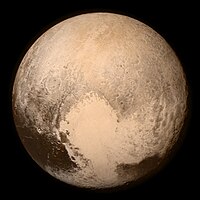NASA releases complete image of Pluto's crescent
Saturday, October 31, 2015
On Thursday, NASA released the first complete picture of Pluto's crescent from the New Horizons probe. The probe captured the image with its Multi-spectral Visible Imaging Camera (MVIC) on July 14, fifteen minutes after closest approach to the planet.
After nine years' journey, New Horizons made closest approach to Pluto on July 14 and released the first coloured photo of the dwarf planet's atmospheric haze on October 8. An incomplete crescent photo of Pluto was released in September.
The photo shows different layers of the haze of Pluto's faint atmosphere with Sputnik Planum, an icy plain, visible on the right side and uneven plateaus on the dark left side.
Charon's Craters
Scientists also announced their discovery that 5km wide Organa crater on Charon, the largest satellite of Pluto, absorbed large amount of radiation of wavelength 2.2µm in an infrared scan, evidence of frozen ammonia. A nearby crater, named Skywalker, of comparable size showed the presence of water ice.
Will Grundy from the New Horizons composition team said "Why are these two similar-looking and similar-sized craters, so near to each other, so compositionally distinct?" He also proposed various ideas about the abundance of ammonia. The impact creating the crater could be more recent, or may have hit a subsurface ammonia pocket, or brought ammonia with it.
Studies in 2000 revealed that Charon has ammonia, but its concentration in the Organa crater was extraordinarily high.
Bill McKinnon, New Horizons Geology, Geophysics and Imaging deputy lead, called it "a fantastic discovery". He further said "Concentrated ammonia is a powerful antifreeze on icy worlds, and if the ammonia really is from Charon’s interior, it could help explain the formation of Charon's surface by cryovolcanism, via the eruption of cold, ammonia-water magmas."

Image: NASA/JHUAPL/SwRI.

Image: NASA/JHUAPL/SwRI.
Related news
- "After Mars, NASA announces water ice on Pluto" — Wikinews, October 9, 2015
- "NASA's New Horizons space probe performs first close planetary flyby of Pluto" — Wikinews, July 17, 2015
Sources
- Tricia Talbert. "The Youngest Crater on Charon?" — NASA, October 29, 2015
- Tricia Talbert. "A Full View of Pluto’s Stunning Crescent" — NASA, October 29, 2015
- Eric Berger. "New Horizons returns stunning image of Pluto backlit by the Sun" — Ars Technica, October 29, 2015
- Loren Grush. "NASA releases full, jaw-dropping view of Pluto's crescent" — The Verge, October 29, 2015


